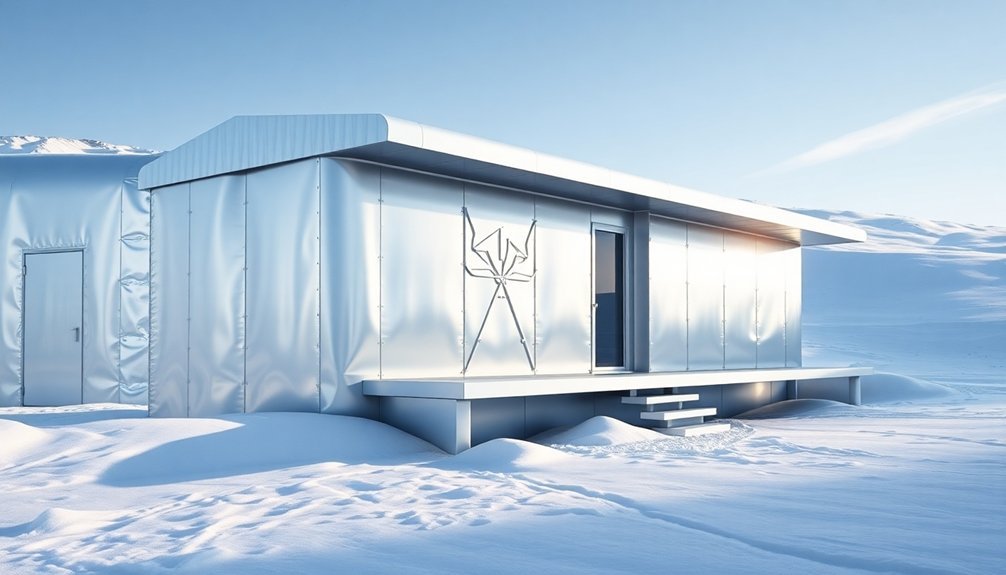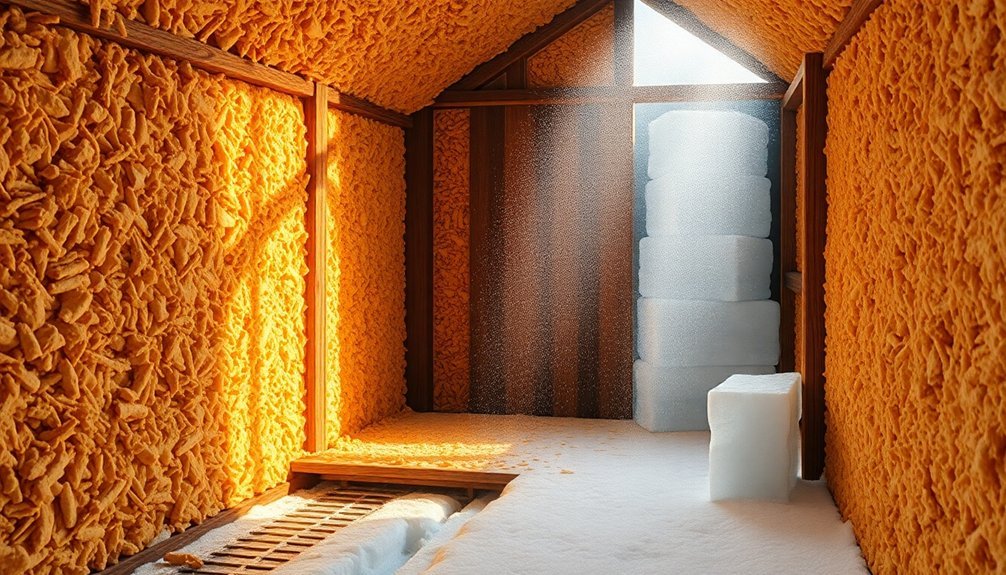Your ice house will stay functional year-round when you focus on five critical elements. Start with smart drainage systems to direct meltwater away from your stored ice. Add thick insulation (1-2 feet) around ice blocks using dry materials like sawdust, and maintain proper ventilation through strategic air holes. Keep your ice elevated on wooden platforms to prevent contact with standing water, and pack blocks tightly to minimize melting. Don't forget natural shade solutions like deciduous trees on the western side. Master these fundamentals, and you'll discover the secrets to keeping your ice house effective through every season.
Smart Design Elements That Matter

To maximize ice preservation, you'll need proper drainage systems built into the base.
Install drains that direct water away from the ice, and guarantee your floor design allows any meltwater to soak away without contacting the stored ice.
Sandy or gravelly soils provide perfect natural drainage for ice house construction.
Insulation: Your Temperature Control Guardian
Proper insulation serves as the cornerstone of any effective ice house, acting as your primary defense against unwanted temperature fluctuations. You'll need to focus on strategic placement, using materials like sawdust, straw, or rock wool between your ice house's inner and outer walls. These materials create a protective barrier that keeps your ice solid for months, potentially lasting until late fall. Building in a shady location helps maximize your insulation's effectiveness.
To maintain ideal insulation efficiency, you'll need to:
- Pack insulation materials 1-2 feet thick on top of the inner room and around each ice block
- Replace old, damp sawdust with fresh material annually
- Check regularly for compromised areas, especially after severe weather
- Keep all insulation materials completely dry to prevent accelerated ice melting
Your choice of insulation material matters greatly. While traditional options like sawdust and wood shavings remain popular, you might also consider tanbark or rock wool for the space between walls.
Remember to extend your insulation to the doors, matching their thickness to the wall cavity depth. With proper maintenance and attention to these details, you're ensuring your ice house remains functional throughout the year, minimizing ice loss and replacement needs.
Air Flow and Water Management

Building on your insulation strategy, effective air flow and water management work together to maximize your ice house's performance.
Just as with standard HVAC systems, proper air balancing is crucial for maintaining consistent temperatures throughout your ice house. You'll need to guarantee proper ventilation through strategically placed holes near the roof and sides of your structure. These openings let warm air escape while maintaining essential air circulation. Including a six-inch air space between your inner and outer walls will further enhance airflow, considerably reducing the rate at which your ice melts.
Water management is equally important, as standing water can quickly compromise your ice storage. You'll want to incorporate an effective drainage system that prevents ice from sitting in water, which conducts heat and accelerates melting.
Start by building your ice house on bare dirt ground for natural drainage, and elevate your ice using wooden blocks or platforms. This elevation creates a space for water to drain away from your ice blocks.
Don't forget to add moisture-absorbing materials like straw mats or sawdust around your ice – they'll help keep your ice dry by soaking up any excess moisture.
With proper attention to these air flow and water management details, you'll maintain ideal conditions for long-term ice preservation.
Natural Shade Solutions
Four natural shade solutions can greatly enhance your ice house's cooling efficiency and reduce melting. By strategically implementing these natural solutions, you'll create a cooler microclimate that helps maintain lower temperatures and protects your ice supply throughout the year.
- Plant deciduous trees on the western side of your ice house, where they'll provide essential summer shade while allowing beneficial winter sunlight. These trees can lower surface temperatures by up to 45°F.
- Install a pergola or arbor adjacent to your ice house, equipped with a lattice roof and retractable covers. You can add curtains or slats to block indirect rays and adjust the shade coverage as needed.
- Grow fast-growing vines like morning glories or ivy on trellises against your ice house walls. These perennial plants create natural insulation and shade without yearly replanting.
- Position privacy screens or slatted fences strategically around your ice house, focusing on areas with high sun exposure. Combine these structures with climbing plants to maximize shade coverage and create additional cooling effects through plant transpiration.
Remember to take into account root systems and structural impacts when placing trees or installing shade structures near your ice house.
Ice Block Storage Techniques

Successful ice block storage relies on a combination of careful insulation, strategic packing, and efficient drainage systems. To maximize your ice house's effectiveness, you'll need to focus on proper block placement and insulation techniques that prevent rapid melting.
Start by creating a raised platform using wooden blocks to keep your ice elevated from the ground. This setup allows meltwater to drain away effectively and prevents direct contact with the floor.
When you're stacking ice blocks, use square shapes whenever possible, as they'll minimize surface area and reduce melting rates. Pack the blocks tightly together, and if you're working with irregular pieces, break them down and pound them into a consolidated mass.
Don't let your ice blocks touch the walls directly. Instead, maintain a space between the ice and walls, filling these gaps with dry sawdust or similar insulating materials.
You'll want to guarantee there's adequate insulation on all sides – including underneath and above the ice. Remember to implement proper drainage channels to direct any meltwater away from your stored ice, as standing water will accelerate melting and compromise your storage system's effectiveness.
Frequently Asked Questions
How Much Does It Cost to Build a Traditional Ice House?
You'll spend between $2,000-$5,000 building a traditional ice house, depending on your material choices and size. If you're using local materials and doing the labor yourself, costs can be considerably lower.
Can an Ice House Be Used to Store Other Perishable Items?
Yes, you can store various perishables in your ice house. By using separate storage areas and maintaining proper airflow, you'll successfully preserve meats, dairy products, and beverages alongside your ice supply.
What Is the Average Lifespan of a Properly Maintained Ice House?
You can expect your well-maintained ice house to last 15-20 years. With proper insulation, regular repairs, and protection from weather damage, it'll serve you longer than a commercial ice machine's typical lifespan.
How Often Should Ice Blocks Be Replaced Throughout the Year?
You'll need to replace ice blocks once annually, typically during winter harvest. With proper insulation and packing, your ice should last through October or November, though larger icehouses can preserve ice until Christmas.
Are There Building Permits Required for Constructing an Ice House?
You'll likely need a building permit for your ice house, depending on its size and local regulations. Check with your local building department, as permits are typically required for structures over 120 square feet.
In Summary
You'll find your ice house stays functional year-round when you combine these key elements effectively. By focusing on proper insulation, managing airflow, controlling water drainage, maximizing natural shade, and using smart ice block storage techniques, you're creating an environment that fights heat transfer. Remember, it's not just about one feature – your success depends on how well you integrate all these components into a complete system.





Leave a Reply